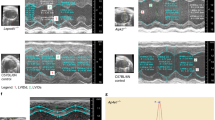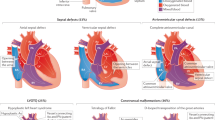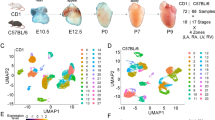Abstract
Congenital heart disease is the leading non-infectious cause of death in children. It is becoming increasingly clear that many cardiac abnormalities once thought to have multifactorial aetiologies are attributable to mutations in developmental control genes. The consequences of these mutations can be manifest at birth as life-threatening cardiac malformations or later as more subtle cardiac abnormalities. Understanding the genetic underpinnings of cardiac development has important implications not only for understanding congenital heart disease, but also for the possibility of cardiac repair through genetic reprogramming of non-cardiac cells to a cardiogenic fate.
This is a preview of subscription content, access via your institution
Access options
Subscribe to this journal
Receive 51 print issues and online access
$199.00 per year
only $3.90 per issue
Buy this article
- Purchase on Springer Link
- Instant access to full article PDF
Prices may be subject to local taxes which are calculated during checkout


Similar content being viewed by others
References
Schultheis, T. M., Xydas, S. & Lassar A. B. Induction of avian cardiac myogenesis by anterior endoderm . Development 121, 4203– 4214 (1995).
Harvey, R. P. NK-2 homeobox genes and heart development. Dev. Biol. 178, 203–216 (1996).
Gajewski, K., Kim, Y., Lee, Y. M., Olson, E. N. & Schulz, R. A. D-Mef2: a target for tinman activation during Drosophila heart development. EMBO J. 16, 515–522 (1998).
Durocher, D., Charron, F., Warren, R., Schwartz, R. J. & Nemer, M. The cardiac transcription factors Nkx2-5 and GATA-4 are mutual cofactors. EMBO J. 16, 5687– 5696 (1997).
Schwartz, R. J. & Olson, E. N. Building the heart piece by piece: modularity of cis elements regulating Nkx2.5 transcription. Development 126, 4187– 4192 (1999).
Fu, Y., Yan, W., Mohun, T. J. & Evans, S. M. Vertebrate tinman homologues XNkx2-3 and XNkx2-5 are required for heart formation in a functionally redundant manner. Development 125, 4439– 4449 (1998).
Grow, M. W. & Kreig, P. A. Tinman function is essential for vertebrate heart development: elimination of cardiac differentiation by dominant inhibitory mutants of the tinman-related genes, XNkx2-3 and XNkx2-5. Dev. Biol. 204, 187–196 (1998).
Molkentin, J., Lin, Q., Duncan, S. A. & Olson, E. N. Requirement of the GATA4 transcription factor for heart tube formation and ventral morphogenesis . Genes Dev. 11, 1061–1072 (1997).
Kuo, C. T. et al. GATA4 transcription factor is required for ventral morphogenesis and heart tube formation. Genes Dev. 11, 1048–1060 (1997).
Reiter, J. F. et al. Gata5 is required for the development of the heart and endoderm in zebrafish. Genes Dev. 13, 2983–2995 (1999).
Capdevila, J., Vogan, K. J., Tabin, C. J. & Belmonte, J. C. Mechanisms of left–right determination in vertebrates. Cell 101, 9–21 ( 2000).
Hyer, J. et al. Induction of Purkinje fiber differentiation by coronary arterialization . Proc. Natl Acad. Sci. USA 96, 13214– 13218 (1999).
Srivastava, D., Cserjesi, P. & Olson, E. N. New subclass of bHLH proteins required for cardiac morphogenesis. Science 270, 1995– 1999 (1995).
Srivastava, D. et al. Regulation of cardiac mesodermal and neural crest development by the bHLH transcription factor, dHAND. Nature Genet. 16, 154–160 (1997).
Firulli, A. B., McFadden, D. G., Lin, Q., Srivastava, D. & Olson, E. N. Heart and extra embryonic mesodermal defects in mouse embryos lacking the bHLH transcription factor Hand1. Nature Genet. 8, 266–270 ( 1998).
Riley, P., Anson-Cartwright, L. & Cross, J. C. The Hand1 bHLH transcription factor is essential for placentation and cardiac morphogenesis. Nature Genet. 18, 271–275 (1998).
Biben, C. & Harvey, R. P. Homeodomain factor Nkx2-5 controls left/right asymmetric expression of bHLH gene eHand during murine heart development. Genes Dev. 11, 1357– 1369 (1997).
Bao, Z., Bruneau, B. G., Seidman, J. G., Seidman, C. E. & Cepko, C. L. Regulation of chamber-specific gene expression in the developing heart by Irx4. Science 283, 1161–1164 (1999).
Bruneau, B. G. et al. Cardiac expression of the ventricle-specific homeobox gene Irx4 is modulated by Nkx2-5 and dHand. Dev. Biol. 217, 266–277 (2000).
Yelon, D. et al. Parallel roles for the bHLH transcription factor HAND2 in zebrafish and pectoral fin development. Development 127, 2573–2582 (2000).
Lin, Q., Schwarz, J., Bucana, C. & Olson, E. N. Control of mouse cardiac morphogenesis and myogenesis by transcription factor MEF2C. Science. 276, 1404–1407 (1997).
Pereira, F. A., Qui, Y., Zhou, G., Tsai, M. & Tsai, S. The orphan nuclear receptor COUP-TFII is required for angiogenesis and heart development. Genes Dev. 13, 1037– 1049 (1999).
Dyson, E. et al. Atrial-like phenotype is associated with embryonic ventricular failure in retinoid X receptor alpha−/− mice. Proc. Natl Acad. Sci. USA 92, 7386–7390 (1995).
Lee, K. F. et al. Requirement for neuregulin receptor erbB2 in neural and cardiac development. Nature 378, 394– 398 (1995).
Carmeliet, P. et al. Abnormal blood vessel development and lethality in embryos lacking a single VEGF allele. Nature 380, 435–439 (1996).
Suri, C. et al. Requisite role of angiopoietin-1, a ligand for the TIE2 receptor, during embryonic angiogenesis. Cell 87, 1171–1180 (1996).
Brown, C. B., Boyer, A. S., Runyan, R. B. & Barnett, J. V. Requirement of type III TGF beta receptor for endocardial cell transformation in the heart. Science 283, 2080– 2082 (1999).
Ranger, A. M. et al. The transcription factor NF-ATc is essential for cardiac valve formation. Nature 392, 186– 190 (1998).
De la Pompa, J. L. et al. Role of the NF-ATc transcription factor in morphogenesis of cardiac valves and septum. Nature 392, 182 –186 (1998).
Galvin, K. M. et al. A role for smad6 in development and homeostasis of the cardiovascular system. Nature Genet. 24, 171– 174 (2000).
Kirby, M. L. & Waldo, K. L. Neural crest and cardiovascular patterning. Circ. Res. 77, 211– 215 (1995).
Kurihara, Y. et al. Aortic arch malformations and ventricular septal defect in mice deficient in endothelin-1. J. Clin. Invest. 96 , 293–300 (1995).
Clouthier, D. E. et al. Cranial and cardiac neural crest defects in endothelin-A receptor-deficient mice. Development 125, 813– 824 (1998).
Thomas, T. et al. A signaling cascade involving endothelin-1, dHAND and Msx1 regulates development of neural crest-derived branchial arch mesenchyme. Development 125, 3005–3014 (1998).
Yamagishi, H., Olson, E. N. & Srivastava, D. The bHLH transcription factor, dHAND, is required for vascular development. J. Clin. Invest. 105, 261–270 (2000).
Kawasaki, T. et al. A requirement for neuropilin-1 in embryonic vessel formation . Development 126, 4854– 4902 (1999).
Iida, K. et al. Essential roles of the winged helix transcription factor MFH-1 in aortic arch patterning and skeletogenesis. Development 124, 4627–4638 (1997).
Li, J., Liu, K. C., Jin, F., Lu, M. M. & Epstein, J. A. Transgenic rescue of congenital heart disease and spina bifida in Splotch mice. Development 126, 2495–2503 (1999).
Gruber, P. J. et al. RXR alpha deficiency confers genetic susceptibility for aortic sac, conotruncal, atrioventricular cushion, and ventricular muscle defects in mice. J. Clin. Inv. 98, 1332– 1343 (1996).
Zhong, T. P., Rosenberg, M., Mohideen, M. A., Weinstein, B. & Fishman, M. C. Gridlock, an HLH gene required for assembly of the aorta in zebrafish. Science 287 , 1820–1824 (2000).
Satoda, M. et al. Mutations in TFAP2B cause Char syndrome, a familial form of patent ductus arteriosus. Nature Genet. 25, 42–46 (2000).
Emanuel, B. S., Budarf, M. L., & Scambler, P. J. in Heart Development (eds Harvey, R. P. & Rosenthal, N.) 463–478 (Academic, New York, 1998).
Lindsay, E. A. et al. Congenital heart disease in mice deficient for the DiGeorge syndrome region. Nature 401, 379– 383 (1999).
Yamagishi, H., Garg, V., Matsuoka, R., Thomas, T. & Srivastava, D. A molecular pathway revealing a genetic basis for human cardiac and craniofacial defects. Science 283, 1158–1161 (1999).
Schott, J.-J. et al. Congenital heart disease caused by mutations in the transcription factor NKX2-5. Science 281, 108– 111 (1998).
Benson, D. W. et al. Mutations in the cardiac transcription factor NKX2.5 affect diverse cardiac developmental pathways. J. Clin. Invest. 104, 1567–1573 (1999).
Basson, C. T. et al. Mutations in human TBX5 cause limb and cardiac malformation in Holt-Oram syndrome. Nature Genet. 15, 30–35 (1997).
Li, Q. Y. et al. Holt-Oram syndrome is caused by mutations in TBX5, a member of the Brachyury (T) gene family. Nature Genet. 15, 21–29 (1997).
Basson, C. T. et al. Different TBX5 interactions in heart and limb defined by Holt-Oram syndrome mutations. Proc. Natl Acad. Sci. USA 96, 2919–2924 (1999).
Li, L. et al. Alagille syndrome is caused by mutations in human Jagged1, which encodes a ligand for Notch1. Nature Genet. 16, 243–251 (1997).
Oda, T., Elkahloun, A. G. & Pike, B. L. Mutations in the human Jagged1 gene are responsible for Alagille syndrome. Nature Genet. 16, 235–242 (1997).
Krantz, I. D. et al. Jagged1 mutations in patients ascertained with isolated congenital heart defects. Am. J. Hum. Genet. 84, 56 –60 (1999).
Curran, M. E. et al. The elastin gene is disrupted by a translocation associated with supravalvular aortic stenosis. Cell 73, 159–168 (1993).
Dietz, H. C. et al. Marfan syndrome caused by a recurrent de novo missense mutation in the fibrillin gene. Nature 352, 279– 281 (1991).
Acknowledgements
D.S. is supported by grants from NIH, American Heart Association, March of Dimes and Smile Train. E.N.O. is supported by grants from NIH, Muscular Dystrophy Association, The Robert A. Welch Foundation and the D. W. Reynolds Foundation. The authors thank R. Sahadi and S. Johnson for assistance with graphics.
Author information
Authors and Affiliations
Rights and permissions
About this article
Cite this article
Srivastava, D., Olson, E. A genetic blueprint for cardiac development. Nature 407, 221–226 (2000). https://doi.org/10.1038/35025190
Issue Date:
DOI: https://doi.org/10.1038/35025190
This article is cited by
-
Integrative analyses of biomarkers and pathways for heart failure
BMC Medical Genomics (2022)
-
The Right Ventricle: From Embryologic Development to RV Failure
Current Heart Failure Reports (2022)
-
Effect of left atrial ligation-driven altered inflow hemodynamics on embryonic heart development: clues for prenatal progression of hypoplastic left heart syndrome
Biomechanics and Modeling in Mechanobiology (2021)
-
Right ventricular phenotype, function, and failure: a journey from evolution to clinics
Heart Failure Reviews (2021)
-
[11C]meta-hydroxyephedrine PET evaluation in experimental pulmonary arterial hypertension: Effects of carvedilol of right ventricular sympathetic function
Journal of Nuclear Cardiology (2021)
Comments
By submitting a comment you agree to abide by our Terms and Community Guidelines. If you find something abusive or that does not comply with our terms or guidelines please flag it as inappropriate.



